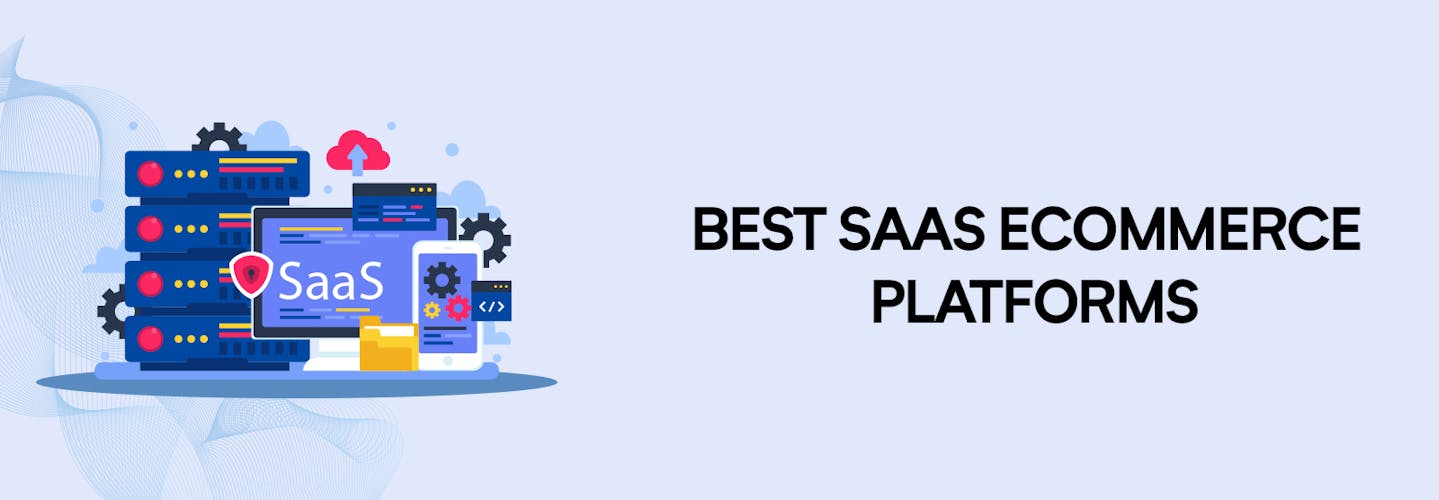
Top 6 Best Saas Ecommerce Platforms You Need to Check in 2025
Hey, you! Ever wondered why some online stores are raking in the big bucks while others are barely scraping by?
The answer often lies in the choice of eCommerce platform. But not just any platform—a SaaS eCommerce platform.
Think about it. You’re spending countless hours perfecting your product, but if your online storefront isn’t up to snuff, all that effort goes down the drain. Sound familiar?
In this article, you’ll discover the crème de la crème [best of the best] SaaS eCommerce platforms and how to leverage them to turn your online store into a revenue-generating machine.
We’re talking about platforms that offer the perfect blend of functionality, scalability, and affordability.
Did you know that the global e-commerce SaaS market was valued at $7056.48 million in 2022 and is expected to grow at a CAGR of 15.32% to $16592.35 million by 2028.
The global SaaS market is expected to grow from $257.47 billion in 2022 to $1298.92 billion by 2030.
So, are you ready to elevate your eCommerce game to the next level? Buckle up, because you’re in for a wild ride!
What are SaaS Ecommerce Platforms?
In the simplest terms, SaaS ecommerce platforms are your one-stop-shop for setting up an online store without the hassle of dealing with complex coding or backend management.
SaaS, or Software as a Service, is a business model that allows you to rent software on a subscription basis. Think of it as Netflix, but for ecommerce solutions.
These platforms offer a range of features, from inventory management to payment gateways, all bundled into one easy-to-use service.
And the best part? They’re cloud-based, which means you can manage your business from anywhere in the world. Talk about convenience, right?
How Does SaaS Ecommerce Work?
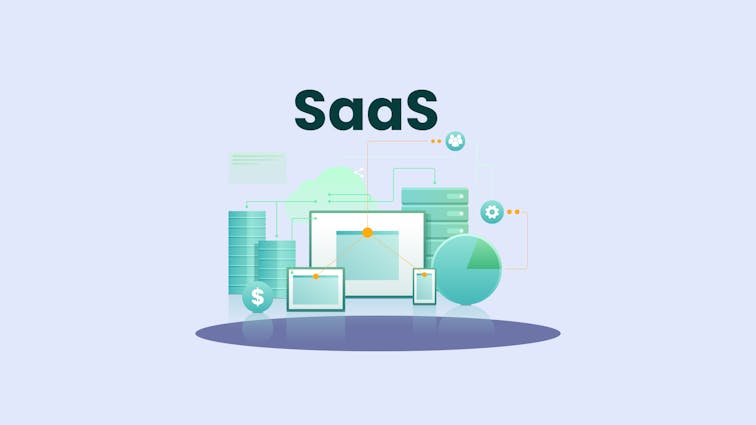
Alright, let’s break it down. Imagine you’re building a house.
The traditional way would involve buying land, sourcing materials, and hiring a whole team of builders, electricians, and plumbers. Sounds exhausting, doesn’t it?
With SaaS ecommerce, it’s like walking into a fully furnished home, where all you have to do is move in.
The platform takes care of all the heavy lifting—hosting, security, updates, you name it. All you need to do is customize it to fit your brand’s unique vibe.
Here’s how it works:
- Select a SaaS Provider: Choose a platform that aligns with your business needs. Look for essential ecommerce features, scalability, and pricing.
- Customize Your Store: Use the platform’s built-in tools to design your store, add products, and set up payment gateways.
- Market Your Business: Leverage the marketing tools provided by the platform to attract customers and drive sales.
- Analyze and Optimize: Most SaaS ecommerce platforms offer analytics tools to help you track performance and make data-driven decisions.
- Grow Your Business: As your business scales, the platform scales with you. Need more features? Just upgrade your subscription.
What is the Difference Between SaaS and Ecommerce?
Hold on a second! Before we dive deeper, let’s clear up some common misconceptions.
You might be wondering, “Aren’t SaaS and ecommerce the same thing?” Well, not exactly.
Ecommerce is the broad term that encompasses all online buying and selling activities. It’s the digital marketplace where transactions happen.
On the other hand, SaaS (Software as a Service) is a software distribution model that provides you with the tools to participate in that marketplace.
In simpler terms, think of ecommerce as the game of basketball. SaaS is like the high-tech basketball shoes that give you the agility and support to play the game better. They’re related but serve different purposes.
What is the Difference Between SaaS and Open-Source Ecommerce?
Ah, the age-old debate: SaaS vs. Open-Source Ecommerce. While both aim to provide you with a platform to sell your products online, the way they operate is as different as night and day.
- Ease of Use: SaaS platforms are generally more user-friendly. They come with built-in features and require zero coding skills. Open-source platforms, however, are like a blank canvas—you need to paint it yourself, which often requires technical expertise.
- Cost: SaaS platforms usually come with a monthly or yearly subscription fee. Open-source platforms might be free to download, but the costs can add up when you factor in hosting, security, and customization.
- Flexibility: Open-source platforms offer more room for customization but at the cost of complexity. SaaS platforms, while less flexible, provide a streamlined, ready-to-use solution.
- Updates and Maintenance: With SaaS, updates are automatic, and maintenance is taken care of by the provider. In the open-source world, you’re on your own.
What are the Benefits of SaaS E-commerce?
So, why should you opt for a SaaS ecommerce platform? Here are some compelling reasons:
- Speed to Market: With pre-built templates and features, you can launch your online store in no time.
- Cost-Effectiveness: No need for a large upfront investment. A monthly subscription covers everything from hosting to updates.
- Scalability: As your business grows, your SaaS platform grows with you. Easily upgrade your plan to add more features or handle more traffic.
- Security: Rest easy knowing that your platform is secure and compliant with industry standards. Most SaaS ecommerce providers take care of security protocols and data backups for you.
- Focus on Business: With the technical side of things handled, you can focus on what you do best—running your business and making sales.
Top 6 Ecommerce SaaS companies in 2025
1. Aasaan
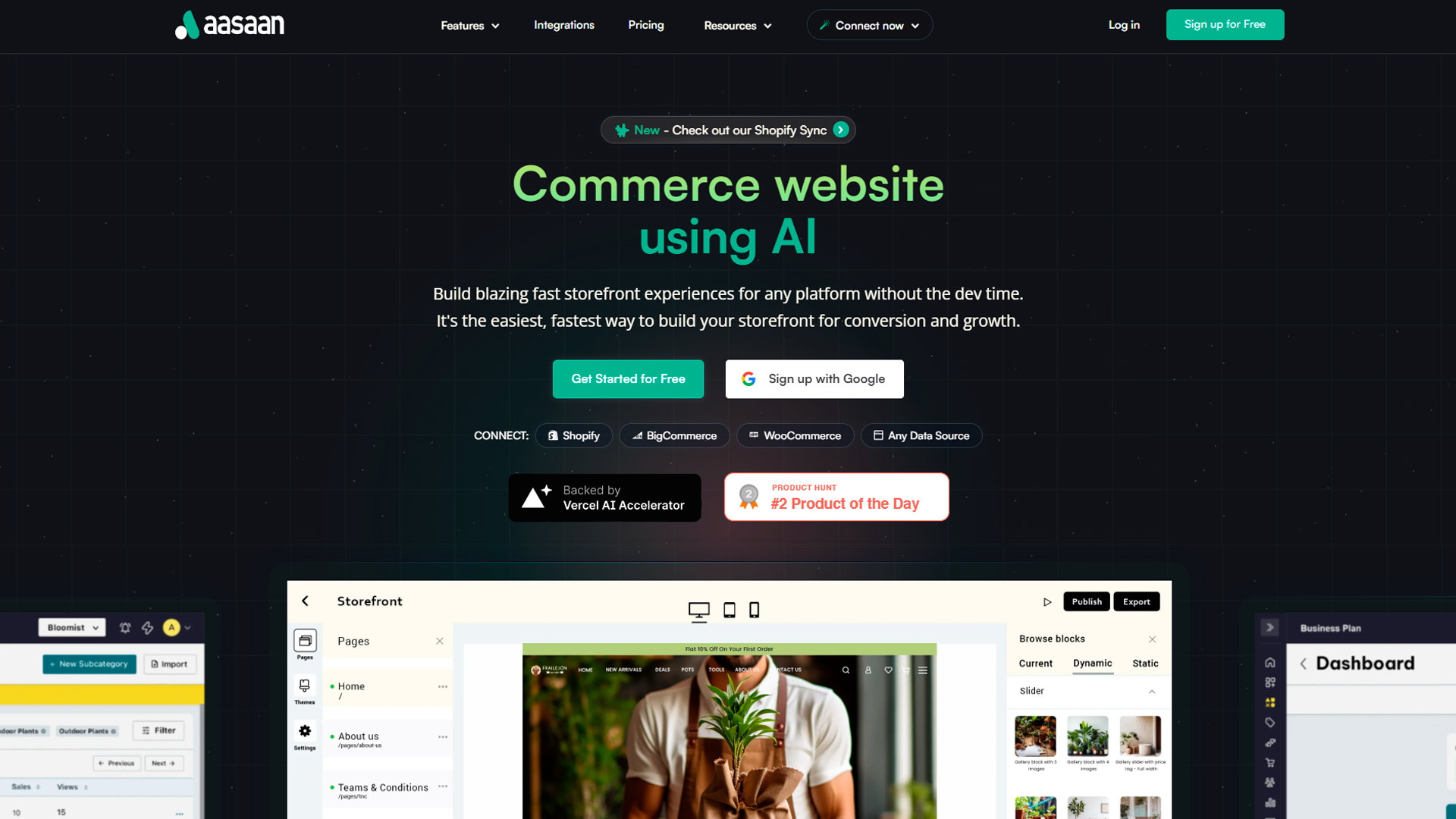
Aasaan App is an e-commerce platform that empowers SMEs to visually build lightning-fast modern shopping experiences quick and easy using its headless storefront builder and API driven commerce platform.
The platform de-risks shopping experiences for merchants by providing an end-to-end infrastructure with zero dev time.
Aasaan App is on a mission to enable SMEs to build exceptional shopping experiences, fast and easy, with best-in-class technology.
Pros:
- Zero-code solution: Aasaan App allows you to create your online store without any coding or design skills. You can use its drag-and-drop interface and pre-built templates to customize your store’s look and feel.
- Headless commerce: Aasaan App leverages the power of headless commerce, which decouples the front-end and back-end of your store. This gives you more flexibility and control over your store’s performance, security, and scalability.
- Powerful e-commerce features: Offers a range of powerful e-commerce features, such as product management, order management, payment processing, and shipping and tax calculators.
- Omnichannel Capabilities: Aasaan app enables businesses to deliver consistent shopping experiences across multiple channels, including web, mobile, social media, and more.
- Multi-channel sales: Aasaan App enables you to sell across multiple channels, such as social media, marketplaces, and mobile apps. You can manage all your sales from a single dashboard and sync your inventory and orders across all channels.
Cons:
- Free Plans include branding
- For now B2B doesn’t support
- Yet to have its own POS system
- Although offers lots of inbuilt marketing tools it does not offer marketing services.
Pricing:
Aasaan App’s pricing plans are tiered based on the number of products, orders, and storage you need.
Aasaan offers several pricing plans:
- Premium Plan: $50 per month
- Business Plan: $165 per month
- Enterprise Plan: Contact Sales
G2 Review:
Aasaan has a rating of 4.8 out of 5 stars on G2, with all reviewers giving it 5 stars. Users have praised its CRM features, which provide an all-encompassing view of customers, helping to improve customer retention.
However, some users have noted limited integration options.
2. Wix overview
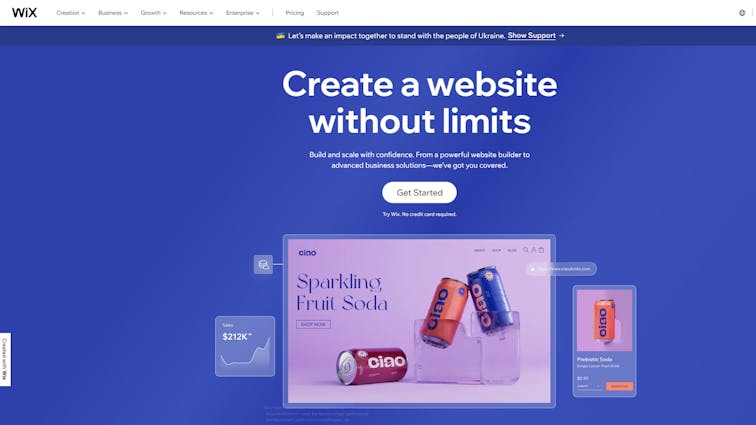
Wix is a popular SaaS (Software as a Service) e-commerce platform that provides users with the tools to create and manage their online stores.
With its user-friendly interface and drag-and-drop website builder, Wix allows individuals, small businesses, and even freelancers to easily set up and customize their online stores without any coding knowledge.
Pros
- User-Friendly Interface: One of the most lauded features of Wix is its drag-and-drop interface. Even if you’re a complete newbie, you’ll find it incredibly easy to set up your online store.
- Built-in SEO: Wix provides built-in SEO tools to help you improve your site’s ranking in search engine results pages (SERPs).
- 200+ App integrations available: You can add advanced features to your website with no coding knowledge.
- Robust Marketing Features: From email marketing to social media integrations, Wix offers a suite of marketing tools to help you reach your target audience.
Cons
- Visitor analytics not available on free or Combo plans: This could be a drawback for users who want to track their website traffic.
- Limited Advanced Features: While Wix is great for beginners, it may lack some advanced features that larger ecommerce businesses may require.
- Storage limits on all plans: This could be a limitation for users who need a lot of storage.
- You can’t change templates once your site is live: This means you need to be sure about your template choice before publishing.
- Transaction Fees: Unless you opt for a business plan, Wix charges transaction fees, which can eat into your profits.
Pricing
Wix offers a free plan and paid plans starting at $16 per month. Here are the details of the paid plans:
- Combo: $16.00 Per Month
- Unlimited: $22.00 Per Month
- Pro: $27.00 Per Month
- VIP: $45.00 Per Month
G2 Review
Wix has an overall rating of 4.2 out of 5 stars on G2, indicating that users generally have positive experiences with the platform.
The reviews appreciate its ease of use and straightforward setup, although some users have pointed out software limitations, such as the inability to change a template once a site goes live, or storage limits.
3. Shopify

Shopify is a widely used SaaS e-commerce platform that enables businesses of all sizes to create and manage their online stores.
With its comprehensive features and user-friendly interface, Shopify has gained popularity among entrepreneurs and established brands alike.
Pros
- User-Friendly: Shopify is known for its easy-to-use interface, making it simple for anyone to set up an online store.
- Wide Range of Professional Templates: Shopify provides a vast selection of professionally designed templates that can be customized to create visually appealing and unique online stores.
- Integrations: Shopify offers over 200 app integrations, allowing businesses to add advanced features to their websites.
- Robust E-commerce Features: Shopify offers a range of built-in e-commerce features, including inventory management, secure payment gateways, and shipping integration, allowing businesses to streamline their operations.
Cons
- Expensive: Some users find Shopify’s pricing plans to be on the higher side.
- Integration Issues: While Shopify offers numerous integrations, some users have reported issues while integrating certain apps.
- Customer Service: Some users have reported mixed experiences with Shopify’s customer service.
- Transaction Fees: Shopify charges transaction fees for each sale made on the platform, which can add up for businesses with high sales volumes. However, these fees can be reduced or eliminated by using Shopify Payments.
- Limited Customization Options: While Shopify offers a wide range of templates, the level of customization may be limited compared to some other platforms, requiring advanced coding knowledge for extensive customization.
Pricing
Shopify offers a range of pricing plans to suit different business needs:
- Basic: $29 per month
- Professional: $79 per month
- Unlimited: $299 per month
G2 Review
On G2, Shopify has an overall rating of 4.4 out of 5 stars, indicating that users generally have positive experiences with the platform.
Users appreciate its ease of use and range of e-commerce features, but some have pointed out limitations such as higher pricing and occasional integration issues.
4. Volusion
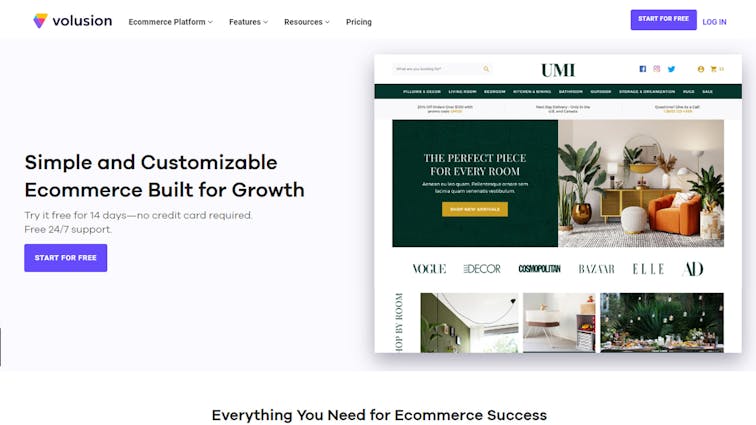
Volusion is a SaaS e-commerce platform that provides businesses with the tools and features to create and manage their online stores.
It offers a range of customizable templates, marketing tools, and integrations to help businesses sell their products or services online.
Pros
- User-Friendly: Volusion is known for its easy-to-use interface, making it simple for anyone to set up an online store.
- Powerful e-commerce features: Offers a range of powerful e-commerce features, such as product management, order management, payment processing, and shipping and tax calculators.
- Integrations: It offers over 200 app integrations, allowing businesses to add advanced features to their websites.
Cons
- Limited integrations: It has fewer integrations with third-party apps and services compared to some other e-commerce platforms, which may limit the functionality of the online store.
- Limited Features for Competitive Marketing: While Volusion is great for small to medium-sized businesses, it may not have the advanced features required by larger e-commerce sites.
- Can’t host a blog internally: This really limits content marketing.
Pricing
Offers a range of pricing plans to suit different business needs:
- Personal: $35 per month
- Professional: $79 per month
- Business: $299 per month
- Prime: Starting at $399 per month
G2 Review
On G2, It has an overall rating of 3.2 out of 5 stars, indicating that users generally have mixed experiences with the platform.
Users appreciate its ease of use and range of e-commerce features, but some have pointed out limitations such as fewer integrations and inability to host a blog internally.
5. Commercetools
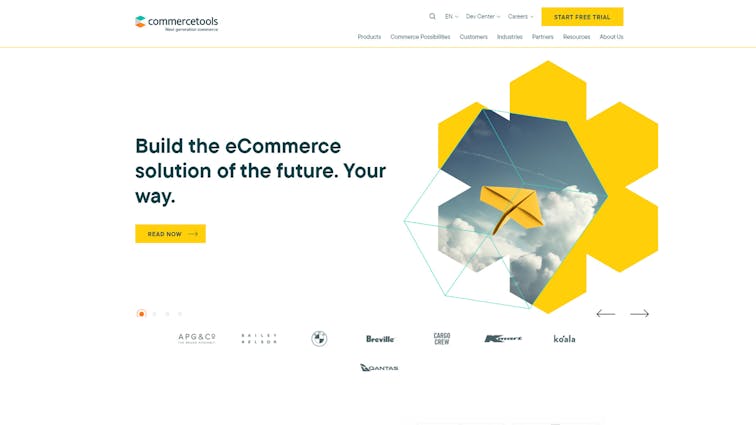
Commercetools is a SaaS e-commerce platform that provides businesses with a flexible and scalable solution for building and managing their online stores.
It focuses on providing headless commerce capabilities, allowing businesses to deliver personalized and omnichannel shopping experiences.
Pros:
- Headless Commerce: It offers a headless architecture, which allows businesses to decouple their front-end and back-end systems, enabling greater flexibility and customization.
- Scalability: Is designed to handle high traffic and large product catalogs, making it suitable for businesses with high growth potential.
- API-First Approach: Commercetools prioritizes its API-first approach, providing businesses with the ability to integrate with various third-party applications and services.
- Flexibility: Commercetools provides businesses with the flexibility to tailor their e-commerce solutions to meet their specific needs, allowing for unique and differentiated customer experiences.
- Omnichannel Capabilities: Commercetools enables businesses to deliver consistent shopping experiences across multiple channels, including web, mobile, social media, and more.
Cons:
- Learning Curve: It may have a steeper learning curve compared to some other e-commerce platforms, requiring technical expertise and development resources to fully utilize its capabilities.
- Higher Cost: It may have a higher cost compared to some other platforms, especially for businesses with complex requirements and high transaction volumes.
Pricing:
- Commercetools offers custom pricing based on the specific needs and requirements of each business. Pricing is typically based on factors such as transaction volumes, number of SKUs, and additional features and services.
G2 Review:
- Commercetools has a G2 rating of 4.4/5, indicating positive user reviews and satisfaction with the platform’s features, scalability, and flexibility.
6. Salesforce cloud commerce
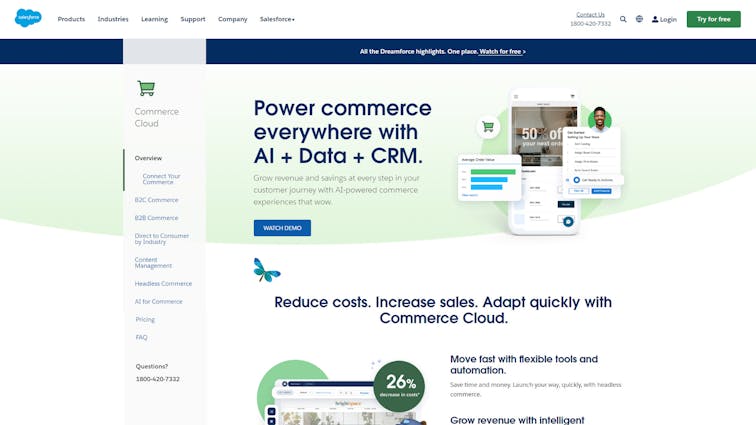
Salesforce Cloud Commerce is a cloud-based commerce platform that provides various out-of-the-box features, useful tools, and commerce portals for growing your online business.
It allows you to streamline the purchasing process, personalize the buying experience, and create a mobile-friendly shopping experience.
Salesforce Cloud Commerce is part of Salesforce Digital 360, an integrated platform allowing you to sell and engage with your audience across digital channels.
Pros
- User Friendly: Salesforce Cloud Commerce is easy to use and integrates well with other clouds such as sales, service, and marketing clouds.
- Data Reports: It provides visibility into customers’ purchasing behavior, allowing better pricing, promotions, and product placement decisions.
Cons
- Customer Service: Some users have reported issues with customer service.
- Learning Curve: There can be a steep learning curve for new users.
Pricing
- B2C and B2B Commerce Clouds have custom pricing based on request
- Quick-start Solutions- $90-390K/ year (implementation services included)
- Starter tier-This tier suits single store owners who have 1 website/store and 2 price books. In this SFCC pricing tier, 1% GMV is charged.
- Growth tier-This tier suits mid-size businesses with up to 5 websites/stores and 10 price books. In this SFCC pricing tier, 1-2% GMV is charged.
- Unlimited tier -This tier suits large-scale companies with complex features. In this SFCC pricing tier, 2% GMV is charged.
G2 Reviews:
Salesforce Cloud Commerce has a rating of 4.2 out of 5 stars on G2. It’s praised for its user-friendly interface and data reporting capabilities.
However, some users have suggested improvements in customer service.
Common challenges of ecommerce SaaS
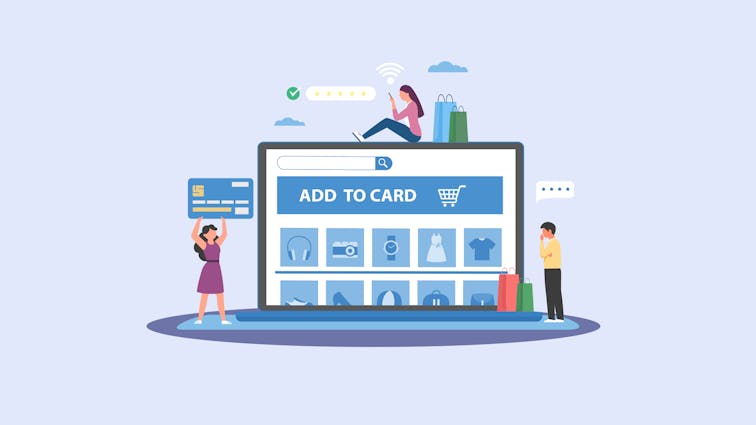
Ecommerce SaaS (Software as a Service) solutions offer numerous benefits such as ease of adoption, flexibility, and cost-efficiency.
However, they also come with their own set of challenges. Here are some common challenges faced by ecommerce SaaS:
- Limited Customization: Ecommerce SaaS platforms are owned by providers and run on their servers. They come as ready-to-use solutions with limited customization options and no access to the source code.
- Tool Redundancy: There can be an overlap in the functionalities offered by different tools, leading to redundancy.
- Cost Management: There’s a need to reduce costs without disrupting processes.
- Avoiding Shadow Tech: Shadow tech refers to the use of software and services without explicit IT department approval.
- Efficient Onboarding and Offboarding: Onboarding new team members efficiently and offboarding them safely is a challenge.
- Product/Service Complexity: The complexity of the product or service can pose a challenge in SaaS sales.
- Unrealistic Expectations: Managing unrealistic expectations from the product/service is another challenge faced in SaaS sales.
- Wasting Resources on Unqualified Leads: Spending time and resources on leads that are not likely to convert is a common challenge.
Remember, these challenges vary based on the specific circumstances of each business. It’s important for businesses to understand these challenges and strategize accordingly to effectively leverage the benefits of ecommerce SaaS solutions.
Conclusion:
The landscape of ecommerce is ever-changing, and choosing the right SaaS ecommerce platform can make or break your online business. This guide aimed to arm you with the knowledge and insights you need to make an informed decision.
Key Points
- What SaaS Ecommerce Is: We explored what top SaaS ecommerce platforms are and how they differ from traditional ecommerce and open-source solutions.
- Platform Overviews: We took a deep dive into major players in the SaaS ecommerce space—Aasaan, Wix, Shopify, and Volusion—highlighting their pros, cons, pricing, and user reviews.
- Benefits of SaaS: We discussed the numerous advantages of opting for a SaaS ecommerce solution, from ease of use to robust analytics tools.
So, are you ready to take the plunge and select the best SaaS ecommerce platform for your business?
Your future success could hinge on this decision. If you’re still unsure and need personalized guidance, don’t hesitate to book a consultation to create your online store today with aasaan.app
SaaS Ecommerce Platforms FAQ’s:
1. Is ecommerce a SaaS?
No, ecommerce is not inherently a SaaS (Software as a Service). Ecommerce refers to the act of buying and selling goods or services online. SaaS, on the other hand, is a software distribution model that can provide the tools to operate an ecommerce business. However, there are ecommerce platforms that operate on a SaaS model, like Aasaan, Shopify and Wix.
2. What is Retail SaaS?
Retail SaaS (Software as a Service) refers to cloud-based software solutions specifically designed for retailers. These platforms offer a range of functionalities such as inventory management, point-of-sale systems, and customer relationship management. Retail SaaS solutions are subscription-based and are hosted on the cloud, making them accessible from anywhere.
3. What is an Example of SaaS?
An example of SaaS in the ecommerce context would be Aasaan. It’s a cloud-based platform that allows businesses to set up an online store and manage it without the need for physical software. Other general examples include Google Workspace, Salesforce, and Zoom.
4. How to Choose the Best Ecommerce SaaS Platform?
Choosing the best ecommerce SaaS platform depends on various factors such as your business size, the products you sell, and your technical expertise. Here are some steps to guide you:
- Identify Your Needs: Know what you’re looking for in terms of features, scalability, and pricing.
- Research: Look into different platforms, read reviews, and maybe even try out a few free trials.
- Compare: Put your top choices side by side and see how they stack up in terms of features and pricing.
- Test: If possible, use the platform for a small project or during a free trial period to see if it meets your needs.
- Consult: Don’t hesitate to seek expert advice or read case studies to make an informed decision.








